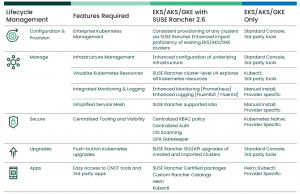Full Lifecycle Management of AKS and GKE clusters now available on SUSE Rancher 2.6
Users have multiple choices for production-ready Kubernetes clusters when they move to the cloud, including Microsoft Azure Kubernetes Service (AKS), Google Kubernetes Engine (GKE), and Amazon Elastic Kubernetes Service (EKS). With the launch of SUSE Rancher 2.6, users now have full lifecycle management support for clusters hosted across the three major cloud providers. Teams utilizing these services traditionally had the option to either use cloud provider-specific tools or manually configure a CNCF tool on their own. With SUSE Rancher 2.6, users can now apply a standard set of CNCF tooling and configuration to manage their Day Two operations across all their clusters.
This is the first release of Rancher since Rancher Labs was acquired by SUSE in December 2020. SUSE offers optional enterprise support subscriptions alongside Rancher, and together this is known as ‘SUSE Rancher’. There are no differences between SUSE Rancher and Rancher, with all features released in SUSE Rancher 2.6 also available in Rancher. Rancher remains 100% open source, backed by the cloud-native open source community.
Microsoft AKS and SUSE Rancher
In SUSE Rancher 2.6, we’ve made it easy to get started on AKS. You can provision new AKS clusters in Azure and have complete control over their configuration and layout. Additionally, SUSE Rancher can launch highly available node groups across multiple availability zones in Azure and can auto-scale those clusters.
If you’ve already been leveraging Azure and AKS in your organization, you can import these clusters into SUSE Rancher 2.6. When you register your AKS cluster with SUSE Rancher, you can immediately start managing cluster upgrades, node pools, and configuration, all through SUSE Rancher’s API. SUSE Rancher provides a common interface for provisioning and managing your Kubernetes clusters wherever they’re running. This means changes made outside of SUSE Rancher will be synchronized, giving cluster admins a consistent view and operational experience.
Google GKE and SUSE Rancher
With SUSE Rancher 2.6, Google Cloud users can quickly launch and use GKE clusters. You can provision clusters that leverage shared VPCs and configure multiple node pools. You can build highly available clusters across multiple zones, and node pools can leverage the GCP native auto-scaling capabilities on their GKE clusters.
Just like with AKS, organizations that already have active GKE clusters can import these clusters into SUSE Rancher 2.6. Once imported or registered, existing clusters can be configured and upgraded with SUSE Rancher instead of the GKE Console. This means users can consistently manage all their Kubernetes clusters with SUSE Rancher, whether deployed by SUSE Rancher or deployed through other means and imported into SUSE Rancher. SUSE Rancher reflects the real-time state of the clusters, so any changes made to the clusters or their configuration outside of SUSE Rancher will instantly be reflected in the SUSE Rancher console.
The benefits of using SUSE Rancher to manage a hosted Kubernetes cluster are clear:

Day Two Operations
Development and operations teams who use SUSE Rancher to manage AKS, GKE, and EKS clusters can utilize a rich set of CNCF tools for Day Two operations. Without SUSE Rancher, teams running clusters in multiple clouds must use tools unique to each cloud provider or roll their own CNCF tooling to achieve similar functionality.
SUSE Rancher’s out-of-the-box monitoring, logging, and scanning tools provide a consistent baseline across all cloud platforms. Users can easily monitor, visualize and set alerts based on metrics from their applications, regardless of the Kubernetes platform they’re using. Alongside this, SUSE Rancher provides CIS scanning profiles for cloud-hosted clusters to round out the features that operators need for their Day Two operations.
Using SUSE Rancher to manage all your hosted cloud Kubernetes solutions like AKS, GKE, and EKS provides a consistent Kubernetes management experience. With SUSE Rancher 2.6, it’s now easier than ever to expand from on-premises to a single or multi-cloud environment with SUSE Rancher’s standard provisioning API and Day Two operation tooling. SUSE Rancher also helps operators manage cluster sprawl by bringing existing clusters under the powerful management of the SUSE Rancher console, a single pane of glass for all of Kubernetes.
Related Articles
Jul 11th, 2022